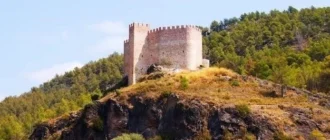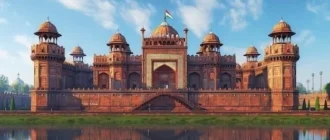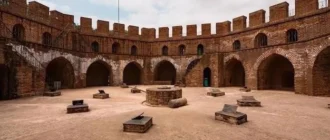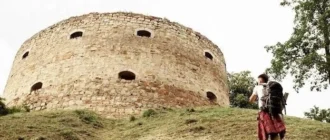Soviet Heritage of Transnistria from Chisinau
Journey back to the Soviet era with an exploration of Transnistria, a breakaway region brimming with preserved monuments, architecture, and cultural remnants of the USSR.
Introduction
Nestled between the Dniester River and Ukraine, Transnistria stands as a poignant testament to a bygone era – a region where the legacy of the Soviet Union continues to permeate daily life. This self-proclaimed republic, officially recognized as part of Moldova, embarked on a path of secession in 1992, driven by a complex interplay of historical, political, and cultural factors. While the international community largely views Transnistria as part of Moldova, the region functions autonomously, maintaining its own government, military, and currency.
For those intrigued by the vestiges of Soviet history, Transnistria offers a captivating experience, a journey back in time to an era marked by distinctive architecture, grand monuments, and a pervasive sense of nostalgia for the USSR. This exploration delves into the Soviet heritage of Transnistria, examining its enduring appeal, key historical sites, and the impact of the ongoing conflict on the preservation and perception of this legacy. From the imposing monuments of Tiraspol to the historical echoes of Bender, Transnistria invites travelers to engage with a complex and often overlooked chapter of European history.
The Appeal of Soviet Nostalgia
The enduring allure of Soviet nostalgia in Transnistria is a multifaceted phenomenon, intricately woven into the social, cultural, and political fabric of the region. While the Soviet Union dissolved in 1991, its memory persists, evoking a complex range of emotions and associations for Transnistrians.
For some, Soviet nostalgia represents a longing for a perceived era of stability, economic security, and social order. The Soviet period saw significant industrial development in Transnistria, with factories and production centers providing employment and a sense of collective purpose. The collapse of the Soviet Union led to economic hardship and uncertainty, contributing to a sense of loss and dislocation that fuels nostalgia for a seemingly more prosperous past.
Beyond economic considerations, Soviet nostalgia also encompasses a yearning for a shared identity and cultural heritage. During the Soviet era, Russian language and culture were promoted, leaving an indelible mark on Transnistrian society. For many, the Soviet past represents a time when their language and cultural expressions were affirmed and celebrated, fostering a sense of belonging within a larger, powerful entity.
Key Soviet Heritage Sites in Transnistria
Transnistria stands as a veritable museum of Soviet heritage, its landscape dotted with monuments, buildings, and cultural artifacts that offer a tangible connection to the USSR. These sites serve as focal points for understanding the region’s complex history and the enduring legacy of the Soviet period.
One of the most prominent Soviet heritage sites in Transnistria is the imposing House of Soviets in Tiraspol, the region’s capital. This grand edifice, with its imposing neoclassical façade and prominent Soviet emblem, embodies the architectural grandeur often associated with Soviet civic buildings. The House of Soviets houses the Transnistrian Supreme Soviet, the region’s parliament, and stands as a symbol of Transnistrian autonomy.
Another key site is the imposing monument to Alexander Suvorov in Tiraspol. Suvorov, a renowned Russian general, played a pivotal role in expanding the Russian Empire in the 18th century. The monument, erected in 1979, depicts Suvorov on horseback, a powerful symbol of Russian military prowess and a reminder of Transnistria’s close historical ties to Russia.
Tiraspol: A Showcase of Soviet Architecture and Monuments
Tiraspol, the capital city of Transnistria, stands as a veritable open-air museum of Soviet-era architecture and monumental grandeur. The city’s streetscape reflects a conscious effort to project an image of strength, permanence, and unwavering allegiance to the ideals of the Soviet Union. Wide boulevards, lined with imposing buildings and adorned with monumental sculptures, evoke a sense of awe and evoke a bygone era.
The centerpiece of Tiraspol’s Soviet heritage is undoubtedly the imposing House of Soviets, a grand edifice that dominates the city center. Completed in 1956, this monumental structure, with its massive columns, soaring arches, and intricate socialist realist details, exemplifies the architectural style favored by the Soviet regime. The building’s prominence and symbolic significance underscore its role as a seat of power and a tangible representation of Transnistria’s enduring connection to its Soviet past.
Beyond the House of Soviets, Tiraspol boasts a wealth of other Soviet-era landmarks, each contributing to the city’s distinctive ambiance. The imposing statue of Alexander Suvorov, a celebrated Russian general, stands as a testament to Transnistria’s complex historical relationship with Russia.
Bender: Fortress, Memorials, and Soviet Influence
Bender, situated on the western bank of the Dniester River, stands as a city steeped in history, bearing witness to centuries of conflict, conquest, and cultural exchange. Known for its strategic importance, Bender has been a coveted prize for various empires, leaving an indelible mark on its architectural landscape and cultural fabric. The city’s layered past is particularly evident in its juxtaposition of Ottoman-era fortifications, Soviet-era monuments, and contemporary Transnistrian life.
Dominating Bender’s skyline is the imposing Bender Fortress, a 16th-century Ottoman stronghold that has withstood numerous sieges and witnessed pivotal moments in European history. The fortress, with its massive walls, imposing gates, and strategic location overlooking the Dniester River, serves as a reminder of Bender’s turbulent past and its role as a crossroads of empires.
While the Bender Fortress speaks to the city’s pre-Soviet past, Bender also bears the indelible mark of the Soviet era, particularly in its monuments and memorials commemorating World War II. The city’s central park features a solemn memorial complex dedicated to the memory of Soviet soldiers and civilians who perished during the war.
Understanding the Transnistrian Conflict and its Impact on Heritage
The frozen conflict between Transnistria and Moldova casts a long shadow over the region, shaping not only its political and economic landscape but also influencing the preservation and perception of its Soviet heritage. The conflict, which erupted in 1992 following the collapse of the Soviet Union, stemmed from complex historical, linguistic, and cultural divisions between Transnistria, with its predominantly Russian-speaking population, and Moldova, which sought closer ties with Romania.
The unresolved nature of the conflict has had a profound impact on Transnistria’s cultural heritage. On one hand, the region’s isolation and lack of international recognition have, in some ways, shielded its Soviet-era monuments and architecture from the wave of demolition and alteration that swept across many former Soviet republics after 1991. In Transnistria, Soviet-era symbols and monuments remain largely intact, serving as potent reminders of the region’s contested identity and its enduring ties to Russia.
However, the conflict has also hindered efforts to preserve and objectively contextualize Transnistria’s Soviet heritage. The lack of a comprehensive peace settlement and the ongoing political tensions between Transnistria and Moldova have made it challenging to foster cross-border collaboration on cultural heritage preservation.
Tours and Experiences: Exploring Soviet Transnistria
Venturing into Transnistria offers a unique opportunity to step back in time and witness the enduring legacy of the Soviet era firsthand. While shrouded in political complexities, Transnistria welcomes intrepid travelers seeking to delve into its rich history and experience its distinctive blend of Soviet nostalgia and contemporary life. Numerous tour operators specialize in guided excursions to Transnistria, providing safe and informative journeys into this often-misunderstood region.
Guided tours typically commence in Chisinau, the capital of Moldova, and include transportation across the de facto border into Transnistria. Visitors are required to obtain a temporary entry permit upon arrival, a straightforward process facilitated by tour organizers. Once inside Transnistria, travelers can expect to encounter a fascinating blend of Soviet-era relics, architectural marvels, and cultural experiences that offer a glimpse into a bygone era.
A typical itinerary might include visits to Tiraspol, the region’s capital, where travelers can marvel at the imposing House of Soviets, pay respects at the Suvorov Monument, and explore the city’s grand boulevards lined with Soviet-era buildings adorned with intricate mosaics and socialist realist artwork.
Guided Tours: Delving Deeper into History and Significance
For those seeking a more comprehensive understanding of Transnistria’s Soviet heritage, guided tours offer invaluable insights and access to knowledgeable experts. Local guides, often with personal connections to the region’s Soviet past, provide nuanced perspectives on the historical events, cultural influences, and political complexities that have shaped Transnistria.
Guided tours delve beyond the surface of iconic monuments and landmarks, offering opportunities to engage with Transnistrian residents and hear firsthand accounts of life during and after the Soviet era. Visits to local museums, such as the Museum of Local Lore in Tiraspol or the Bendery Historical and Archaeological Museum, provide curated glimpses into the region’s rich and often turbulent history, showcasing artifacts, documents, and photographs that illuminate the Soviet period and its impact on Transnistrian society.
Moreover, guided tours often incorporate visits to lesser-known sites of Soviet significance, such as former collective farms, factories, or cultural centers, offering a tangible sense of the Soviet Union’s pervasive influence on everyday life. These immersive experiences allow travelers to move beyond stereotypical representations of the Soviet era, fostering a more nuanced and empathetic understanding of the lived experiences of those who inhabited this period.
Independent Exploration: Discovering Hidden Gems and Local Perspectives
While guided tours offer structured and informative introductions to Transnistria, independent exploration allows for a more immersive and personalized experience, enabling travelers to delve into the region’s nuanced cultural tapestry at their own pace and uncover hidden gems often overlooked by conventional itineraries.
Venturing beyond the well-trodden tourist paths offers opportunities to encounter the genuine warmth and hospitality of the Transnistrian people, engaging in unscripted conversations that reveal local perspectives on history, politics, and daily life. A stroll through Tiraspol’s bustling central market, for example, provides a sensory immersion into the sights, sounds, and aromas of Transnistrian culture, offering glimpses into local culinary traditions and the rhythms of daily commerce.
For those seeking a more contemplative experience, Transnistria’s parks and green spaces offer respites from the urban bustle. A leisurely walk along the banks of the Dniester River, for instance, provides opportunities to observe local life unfold and witness the enduring beauty of the Transnistrian landscape.
Conclusion: Preserving the Past, Navigating the Present
Transnistria’s Soviet heritage stands as a poignant testament to a complex and tumultuous period, offering a tangible link to a bygone era that continues to shape the region’s identity and trajectory. The preservation and interpretation of this legacy, however, remain intertwined with the unresolved political status of Transnistria and the ongoing challenges of fostering reconciliation and cooperation between Chisinau and Tiraspol.
As Transnistria navigates its uncertain future, the preservation of its Soviet-era monuments, architecture, and cultural memory presents both opportunities and challenges. On one hand, these tangible remnants of the Soviet past serve as important reminders of the region’s shared history, fostering a sense of collective identity and providing valuable insights into the lived experiences of Transnistrians during the Soviet era.
On the other hand, the interpretation and presentation of this heritage require sensitivity, nuance, and a commitment to avoiding the pitfalls of nostalgia or historical revisionism. Striking a balance between preserving the past and navigating the complexities of the present is crucial for fostering a more inclusive and understanding future for Transnistria.










